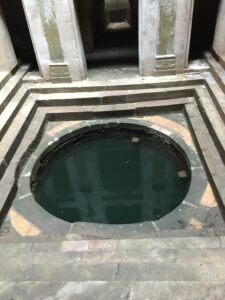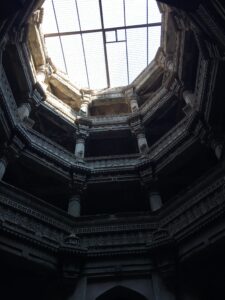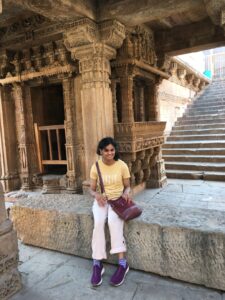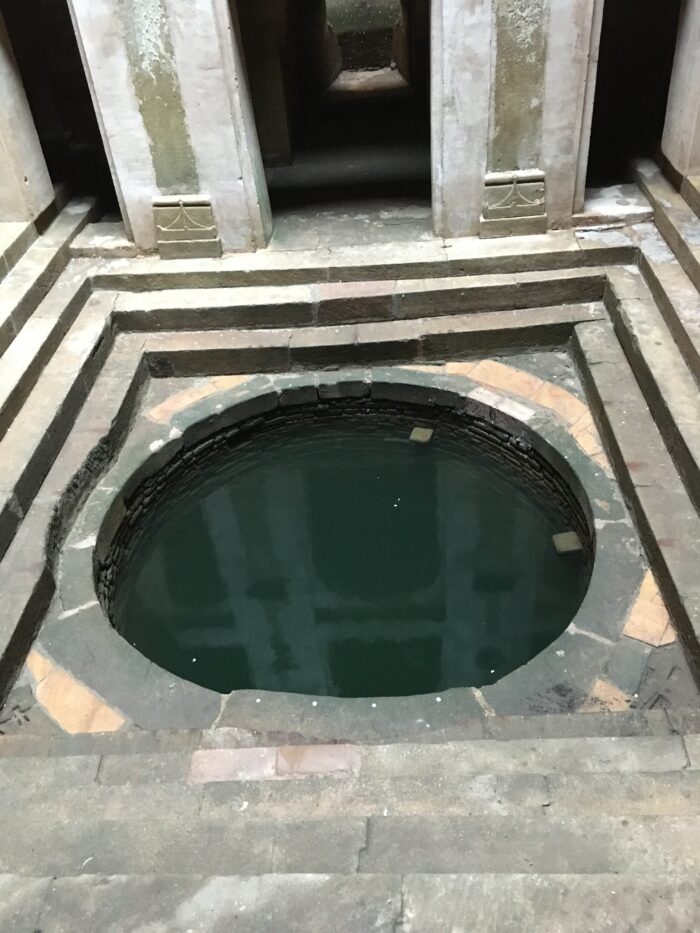By Amita Bhakta
This blog was originally written for and published by the Rural Water Supply Network and is available here.

India’s rural stepwells (or vavs, baolis or jhalaras) mark past relationships between communities and local water supply. Today, many are protected by the Archaeological Survey of India as historical sites of heritage. But, in the face of modern-day challenges, this second blog in a two-part series asks, what future lies ahead for these water sources with their intricate architecture, and for their local rural communities? To find out, I went to Adalaj Ni Vav near to Ahmedabad, Gujarat in early 2023.
Gujarat’s rural vavs: under threat from competing demands
More than just a water point, Adalaj Ni Vav is steeped in history with a story of love and tragedy. Yet, as nearby Adalaj village expands to meet the demands of this tourist hotspot, changing surroundings and competing priorities bring new challenges for the future conservation of this stepwell, and others like it. Buses arriving with tourists lack drop off spots. I saw the congestion on the roads leading to the well in the absence of an auto rickshaw stand, with vehicles, pedestrians and street vendors fighting for space.
The water body in the stepwell is also under threat. Local women no longer climb down Adalaj’s steps to collect water. Over time, the water has been polluted due to the influx of visitors dumping plastic into it, contaminating it, and leaving it stagnated, and no longer fit for use[i]. The Urban Management Centre[ii]’s work with the jhalaras of Jodhpur, Rajasthan, has identified challenges of overflowing and flooding during monsoon seasons. As piped water supply reaches every household, water is not collected from the stepwells and they stand neglected. This is despite them being part of a network of natural and artificial reservoirs where upstream water bodies collect the water and transfer it downstream. Lessons can be taken from this work in India’s cities to adopt a renewal approach for the adaptive re-use of rural stepwells such as Adalaj Ni Vav and others.
Sustaining Gujarat’s vavs
At present, there is significant focus on the maintenance and restoration of the sculptural elements of Adalaj Ni Vav, through protective guards that stop the many visitors from directly interacting with the structure, and vigilant caretakers ensuring their upkeep. Coverings over the octagonal well demonstrates the efforts being taken to prevent the water being contaminated by visitors dropping waste from outside the structure into the well.

Protecting and sustaining Gujarat’s vavs for the future also requires interventions from external organisations. Aside from the protection granted for Adalaj by the Archaeological Survey of India, it comes under nearby Ahmedabad’s recognition as a UNESCO World Heritage Site. Gujarat’s Directorate of Archaeology and Museums has been pivotal in efforts to clean the stored water in the state’s vavs, and has a role to play in supporting local authorities to conserve stepwells such as Adalaj for the longer term. As heritage sites, there remains a challenging balance to strike in the longer term. Whilst creating a ‘tourism zone’ through public-private partnerships can generate much needed revenue for the local economy, the re-use of the vav as an attraction should not come at a cost of further harm to the vav from pollution. Ensuring public awareness of the need to conserve vavs as markers of India’s water history is key.
Sustaining vavs for the future involves curation. Stepwells could be turned into ‘living’ water ‘museums’ to teach future generations about the importance of water security as climate change takes hold in India. Converting stepwells to water museums can create awareness of the rich history and the role that Adalaj and other vavs played in supplying water, acting as community hubs, and providing livelihoods for well-digging artisans in the past.
Rural stepwells of the past could inspire engineers and architects of today. As we grapple with the challenges of energy security, we should look to vavs for lessons on integrating light and natural ventilation into buildings of the modern era.
Adaptive reuse of rural vavs can be done creatively. The magnificent architecture that strikes tourists as they descend towards the pool of water can provide a temporary backdrop for outdoor concerts and art exhibitions. Water festivals at stepwells, which can provide exhibition spaces, can incorporate traditional music and stories of their rich past, to educate younger generations about their historical roots and recognise the cultural significance of stepwells for their ancestors.
Looking ahead
Gujarat’s rural stepwells may no longer fulfil their traditional purpose of supplying water, but there is no need to consign these beautiful structures to the past. Let’s look forwards towards routes to celebrate and keep India’s rural water history alive. It’s time we worked together to ensure stepwells continue to play a role in our lives in creative ways.
Acknowledgement
Special thanks to my friend, Mona Iyer, for facilitating this field visit, and to Mahesh Popat for his brilliant support in the field. Thank you to Anurag Anthony for his useful insights to inform this blog. Thank you to the RWSN Secretariat for supporting this visit and to Temple Oraeki for reviewing drafts of this blog.

About the author: Amita Bhakta is a freelance consultant and co-lead for the leave no-one behind theme at the Rural Water Supply Network. She has specialised in looking at hidden issues to achieve equity and inclusion in WASH and has a keen interest in rural water heritage in India.
[i] Srivapathy, U. and Salasha T. 2021. Adalaj Stepwell: A Magical Resonance of Architectural Ingenuity. Athens Journal of Architecture – Volume 7, Issue 2 pp. 275-304
[ii] Anurag Anthony, Urban Management Centre, personal communication, March 2023
